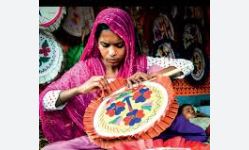By Rabab Hussain
Few development interventions have attracted as much sustained enthusiasm—or as much scrutiny—as microfinance. Heralded as a catalyst for poverty reduction and women’s empowerment, it became a mainstay of development policy across South Asia. The logic was compelling: provide women with small loans, and they would invest in businesses, gain economic independence, and drive social change within their households and communities. The narrative was powerful, and in many ways, it worked.
But decades into the microfinance boom, it’s time to ask a harder question: Has it delivered on its promise?
The answer is complicated.
Microfinance was conceived not merely as a credit tool, but as a mechanism for alleviating poverty and advancing women’s empowerment. Popularised by institutions like Bangladesh’s Grameen Bank and later replicated across India, Pakistan, and Nepal, microfinance quickly gained traction as an intervention in development policy. The logic was simple: women are more likely to invest in their families and communities, and empowering them economically would trigger broader social transformation.
Indeed, access to credit has changed lives. In Pakistan, organisations like the Kashf Foundation and Akhuwat have enabled women to contribute to household incomes and improve their bargaining position at home. In India, Self-Help Groups (SHGs) linked to banks have brought credit to millions of rural women. In Bangladesh, BRAC combines microcredit with education and healthcare, aiming for more sustained improvements in women’s lives.
Yet beyond isolated success stories, structural vulnerabilities persist. Many women remain trapped in debt cycles, often using new loans to service old ones. In Pakistan, World Bank data suggests that between 50-70 percent of microloans taken out by women are actually controlled or spent by male relatives, undermining their autonomy despite being the official borrowers. Moreover, most loans finance low-return, small-scale work with little opportunity for income growth or asset accumulation. For those living on the margins, even minor defaults can lead to financial exclusion.
Too often, we’ve overstated microfinance’s promise—asking too much of it and too little of governments and policymakers. The idea that credit alone can empower women is flawed. Empowerment demands more than access to money—it requires control over resources, decision-making power, and meaningful participation in economic life. Microfinance, in its current form, often falls short of creating these conditions.
The microfinance model has been largely financialized. Institutions boast of near-perfect repayment rates, but rarely track meaningful indicators such as whether women’s incomes have risen, whether they own productive assets, or whether their role in household decision-making has changed. Research supports this skepticism. A large-scale study in Hyderabad by economists Esther Duflo and Abhijit Banerjee found that microcredit had only modest effects on business activity and no significant impact on household income or women’s empowerment. In Bangladesh—the birthplace of the microfinance movement—critics argue that the sector has become more commercial than developmental. In Pakistan, despite steady growth in outreach, many borrowers remain trapped in low-productivity, informal work.
One of the core problems is that microfinance institutions (MFIs) are primarily concerned with repayment rates. In their race to maintain financial sustainability, they seldom ask whether loans are actually improving women’s lives. Institutional pressure to expand loan portfolios and maintain high repayment rates often results in women being encouraged to borrow repeatedly—even when doing so increases financial risk. There is little investment in understanding whether the businesses financed are viable or whether women have access to the markets, skills, or technology needed to grow them. Compounding these challenges are structural inequalities—low education, restricted mobility, and patriarchal norms—that severely limit what women can do with the money they receive. Without addressing these systemic barriers, credit can at best offer coping strategies. As a result, many microenterprises remain subsistence-level, with limited potential for scale or innovation.
So what needs to change?
First, microfinance must be repositioned within a broader ecosystem of support, rather than treated as a standalone intervention. Access to credit should be complemented by skills training, business development services, digital tools, and—crucially—connections to markets. Without these additional resources, loans alone have a limited impact. In India, some Self-Help Groups (SHGs) supported by NGOs go beyond lending, providing women with collective bargaining power, legal awareness, and market linkages—approaches that have shown greater potential for lasting economic empowerment.
Second, policy approaches need to move beyond simply expanding access to credit. Public investment in areas like transport, education, and digital infrastructure is essential to enable rural women to participate more fully in economic life. Governments must also recognise that microfinance institutions can complement—but not replace—public sector responsibilities. Without wider structural reforms—including secure land rights, fair inheritance laws, labour protections, and access to childcare—credit by itself cannot meaningfully shift gender dynamics.
Lastly, we must reframe our metrics for success. High repayment rates should not be confused with empowerment. We must ask tougher questions: Are women’s income growing? Do they have control over their earnings? Are they influencing household or community decisions? Are they moving out of poverty?
None of this is to dismiss the value that microfinance has brought. For many women, it has offered a first taste of financial agency. Yet it remains no panacea. If microfinance is to become a true driver of empowerment in South Asia, it must be embedded within a broader framework of gender justice and inclusive economic reform. Credit can open doors, but it cannot shoulder the burden of social transformation alone. The real question is no longer whether microfinance works—but whether we are willing to invest in the harder, structural work of building fairer, more inclusive systems where women can thrive beyond the loan.
The writer is an undergraduate student of Economics at the Lahore University of Management Sciences (LUMS). Her academic interests lie at the intersection of development and economic policy, with a focus on how structural inequalities shape economic outcomes. She can be reached at [email protected]

















